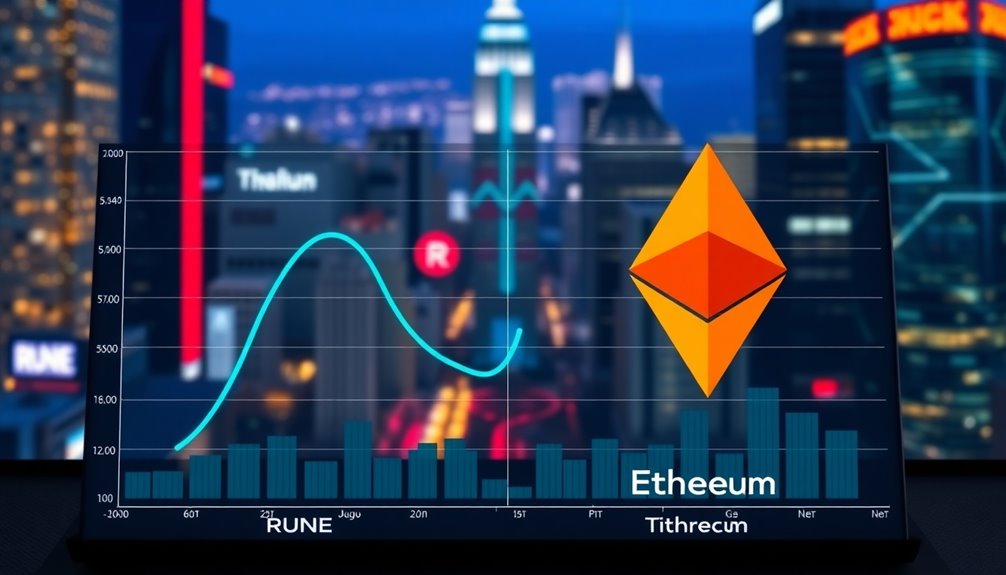RUNE is the native cryptocurrency of THORChain, designed to enable cross-chain transactions across multiple blockchain networks like Bitcoin and Ethereum. It acts as a key asset in a decentralized liquidity network, facilitating seamless swaps without intermediaries. RUNE's unique automated market maker model helps maintain liquidity and rewards users who provide liquidity through swap fees. The total supply of RUNE is capped at 1 billion, enhancing its potential value over time. As you explore further, you'll uncover more about its role in liquidity pools and governance within the THORChain ecosystem.
Key Takeaways
- RUNE is the native asset of THORChain, a decentralized liquidity network facilitating cross-chain swaps.
- It operates on a deflationary model with a capped supply of 500 million tokens post-burn.
- RUNE supports liquidity pools, enabling seamless exchanges of cryptocurrencies across nine major blockchains.
- Liquidity providers earn rewards in RUNE through swap fees, enhancing their overall asset holdings.
- Strategic partnerships with decentralized exchanges boost RUNE's market adoption and cross-chain liquidity.
Core Concepts of RUNE

When you plunge into the core concepts of RUNE, you'll discover that it's more than just a token; it's the backbone of THORChain's decentralized liquidity network.
RUNE serves as the native asset settlement for cross-chain swaps, allowing seamless transactions across multiple blockchains like Bitcoin and Ethereum. As a liquidity provider, you'll earn swap fees, making RUNE essential for the automated market maker (AMM) model.
With a total supply capped at 1 billion—initially reduced to 500 million after a token burn—RUNE embraces a deflationary economic model. Its role in governance enhances the network's security, as node operators bond RUNE to prevent malicious activities.
The price volatility of RUNE also reflects its investment potential in the cryptocurrency market.
Overview of Rune's Ecosystem

THORChain’s ecosystem revolves around RUNE, the native utility token that powers a decentralized liquidity protocol designed for seamless cross-chain asset exchanges. The THORChain protocol overview highlights its unique approach to liquidity provision, enabling users to swap assets across different blockchains without the need for a central authority. By leveraging automated market-making and liquidity pools, THORChain ensures that users can enjoy efficient and secure transactions. Additionally, the decentralized nature of the protocol fosters a more resilient and censorship-resistant financial ecosystem.
With support for native asset settlement across nine blockchains, including Bitcoin, Ethereum, and BNB Chain, THORChain enhances liquidity and trading opportunities.
RUNE plays an essential role in governance, fees, and network security, enabling liquidity providers to earn swap fees through liquidity pools.
The protocol employs an automated market maker (AMM) model, allowing you to swap tokens directly from these pools while minimizing impermanent loss through its fee systems.
With a total supply capped at 1 billion and 500 million RUNE currently in circulation, the token's scarcity can contribute to potential value appreciation.
Liquidity Pools Facilitate Swaps

Liquidity pools are vital for facilitating seamless cross-chain swaps, allowing you to exchange various cryptocurrencies directly without relying on intermediaries.
THORChain's protocol utilizes these liquidity pools by pairing RUNE with native assets, enabling you to swap cryptocurrencies like Bitcoin and Ethereum effortlessly.
As a liquidity provider, you deposit your assets into these pools, which helps maintain their liquidity.
The automated market maker (AMM) model leverages real-time liquidity data to set swap pricing, ensuring efficient transactions while minimizing impermanent losses.
RUNE plays a significant role in these swaps, acting as a key intermediary.
This setup fosters a dynamic ecosystem where you can smoothly navigate the complexities of cross-chain cryptocurrency exchanges within the THORChain framework. Additionally, understanding high volatility risks is crucial for users engaging with these liquidity pools.
Liquidity Provider Rewards

By participating as a liquidity provider, you can earn rewards through swap fees generated from transactions in the liquidity pools you contribute to.
On THORChain, these rewards are distributed in RUNE, the platform's native token, enhancing your cryptocurrency assets. Your yield varies based on market activity, including the total volume of swaps and the amount of liquidity pooled. Consequently, it's crucial to monitor these factors for ideal returns.
Additionally, THORChain's economic model helps mitigate impermanent loss, reducing risks associated with providing liquidity.
With a current RUNE price of $3.44 and a total supply of 422.24 million, understanding the rewards structure can help you make informed decisions as a liquidity provider.
RUNE vs. Ethereum Transaction Fees

When considering the benefits of participating in THORChain, it's important to look at how RUNE compares to Ethereum regarding transaction fees.
RUNE typically incurs lower fees, especially during Ethereum's peak congestion, where gas fees can soar beyond $50.
THORChain employs a slip-based fee system that adapts to market conditions, minimizing impermanent losses for liquidity providers while keeping costs down for users.
You can perform native asset swaps with RUNE without the added complexity of wrapped tokens, which often leads to extra fees on Ethereum.
Plus, RUNE's non-custodial nature means you retain control over your assets during swaps, reducing transaction costs associated with custody solutions prevalent in the Ethereum ecosystem.
Volatility in Market Prices

Although RUNE has shown potential for growth, it's important to recognize the significant volatility in its market prices.
Recently, RUNE experienced a price change of -28.96% over the past week, dropping to a current price of $3.44 from $4.85 just a week ago. This decline continues a trend, with a 47.05% drop over the past month and a 24.51% decrease over the year.
Its all-time high of $21.26 starkly contrasts its current valuation, emphasizing the rapid fluctuations typical in decentralized exchanges.
While RUNE's circulating supply plays a role in these dynamics, the market remains unpredictable, making it essential to stay informed about potential risks and opportunities in this volatile environment.
Market Adoption and Partnerships

As the cryptocurrency landscape evolves, RUNE's market adoption is gaining momentum through strategic partnerships and innovative features.
THORChain's collaborations with various decentralized exchanges have notably enhanced cross-chain liquidity, allowing seamless swaps across nine major blockchains, including Bitcoin and Ethereum. This capability boosts user engagement and attracts liquidity providers essential for RUNE's growth.
Additionally, RUNE tokens' integration into popular trading platforms like Binance and THORSwap broadens access, promoting market adoption.
The platform's emphasis on non-custodial transactions and continuous liquidity pools not only enhances its utility but also fosters a robust ecosystem.
Community-driven governance encourages active participation, solidifying user loyalty and RUNE's presence in the ever-evolving cryptocurrency market.
Diversify Liquidity Pool Investments

Diversifying your investments in liquidity pools can greatly enhance your overall returns while managing risk.
By utilizing THORChain, you can deposit multiple assets, including Bitcoin, Ethereum, and Dogecoin, into liquidity pools. This allows you to diversify investments and participate in cross-chain swaps without relying on wrapped tokens.
As a liquidity provider, you'll earn yields from fees generated by swaps, which are distributed among participants, boosting your potential returns.
Additionally, THORChain's fee systems help mitigate impermanent loss and maintain price stability.
RUNE, the native token, serves as a pairing token in these pools, increasing in demand as more assets are added, offering you another layer of investment opportunity while managing your risk effectively.
Frequently Asked Questions
What Is RUNE Crypto Used For?
You'll find RUNE is primarily used for governance within the THORChain ecosystem, letting you vote on network updates and features.
It acts as the main pairing token in liquidity pools, enabling easy swaps between cryptocurrencies. When you provide liquidity, you earn rewards in RUNE.
Additionally, it covers transaction fees, although you don't need to hold it for swaps.
Is RUNE a Good Investment?
When weighing whether RUNE's a wise investment, consider its tumultuous track record.
Its recent price plunge and underwhelming performance against benchmarks might raise red flags.
However, if you're willing to embrace the ecosystem's evolution, the potential for future growth could be enticing.
The ongoing development of THORChain and governance opportunities might enhance RUNE's appeal for dedicated, long-term investors.
Just remember, it's essential to do your own research before diving in!
Can RUNE Reach $100 Dollars?
You might wonder if RUNE can reach $100. While it's currently trading at $3.44, achieving that price requires a significant increase in market cap and demand.
The recent price declines make this journey challenging, but RUNE's utility in cross-chain exchanges and ongoing developments could drive interest.
If the community engages and new integrations emerge, there's potential for growth, but it'll take time and consistent market support to get there.
Is RUNE a Blockchain?
No, RUNE isn't a blockchain.
It's actually the native utility token of the THORChain decentralized liquidity protocol. This protocol operates on the Cosmos SDK and facilitates cross-chain asset exchanges.
Instead of being a standalone blockchain, RUNE plays an essential role in providing liquidity and enabling swaps between different assets.
Conclusion
In summary, exploring RUNE crypto reveals not just a unique ecosystem but also a promising investment opportunity. By participating in liquidity pools, you can earn rewards while contributing to the network's growth. The volatility might seem intimidating, but it's part of the game in crypto. As RUNE gains traction through partnerships and market adoption, you might just find that diversification in liquidity pools could be your ticket to long-term success. So, why not plunge in?









